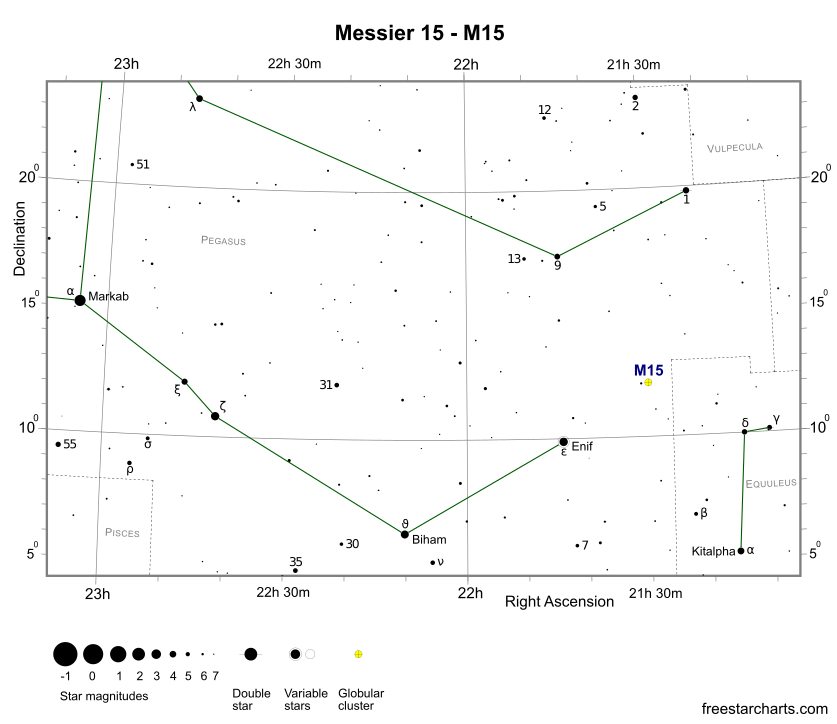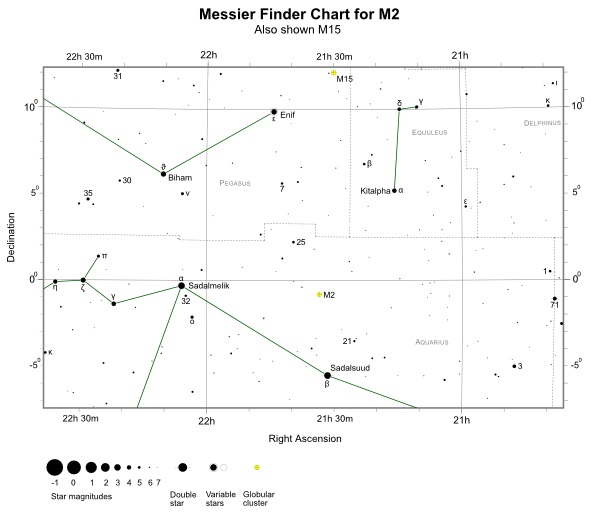M15 is one of the brightest and finest globular clusters in the northern section of the sky and the best deep-sky object in the constellation Pegasus. It's only marginally fainter and smaller than M13, the finest northern globular cluster. M15 is relatively easy to find. It's located 4 degrees to the northwest of Enif (ε Peg - mag. +2.4) and at one edge of a right-angled triangle made up of 6th, 7th and 8th magnitude stars.


Finder Chart for M15 - pdf format (credit:- freestarcharts)

Finder Chart for M2 (also shown M15) - pdf format (credit:- freestarcharts)
Approaching naked eye visibility under excellent conditions, M15 is easily seen with binoculars or finder scopes appearing as a mag. +6.2 "fuzzy star". A 100mm (4-inch) telescope at low power (40x) reveals a uniformly lit disk, while high powers (>100x) hint at resolution of some of the outer stars. When viewed through a larger 200mm (8-inch) scope, M15 looks like a large bright diffuse ball of light with a dense compact centre. Many stars are resolved in the outer halo, the brightest of which shine at mag. +12.6. Larger instruments do even better. A 300mm (12-inch) scope resolves many stars across the complete disk, creating a spectacular 3-dimensional effect. In total, the globular has an apparent diameter of 18 arc minutes. However, it visually appears somewhat smaller, perhaps only 8 arc minutes across.
M15 is one of the most densely packed globulars known in the Milky Way. Its core has undergone a contraction known as "core collapse" resulting in an enormous number of stars surrounding what may be a central black hole. It's also unusual in that it's one of only four known globulars (along with M22, NGC 6441 and Palomar 6) that contain a planetary nebula. The planetary is named Pease 1.
The cluster was discovered by Italian born French astronomer Jean-Dominique Maraldi on September 7, 1746. It's located 33,600 light-years distant. With an age of at least 12.0 billion years, this is one of the oldest known Milky Way globulars.
M15 Data Table
| Messier | 15 |
|---|---|
| NGC | 7078 |
| Object Type | Globular Cluster |
| Constellation | Pegasus |
| Distance (light-years) | 33,600 |
| Apparent Mag. | +6.2 |
| RA (J2000) | 21h 29m 58s |
| DEC (J2000) | +12d 10m 00s |
| Apparent Size (arc mins) | 18 x 18 |
| Radius (light-years) | 88 |
| Age (years) | 12 Billion |